Experiments with liquid nitrogen, plastic bottles and table tennis balls
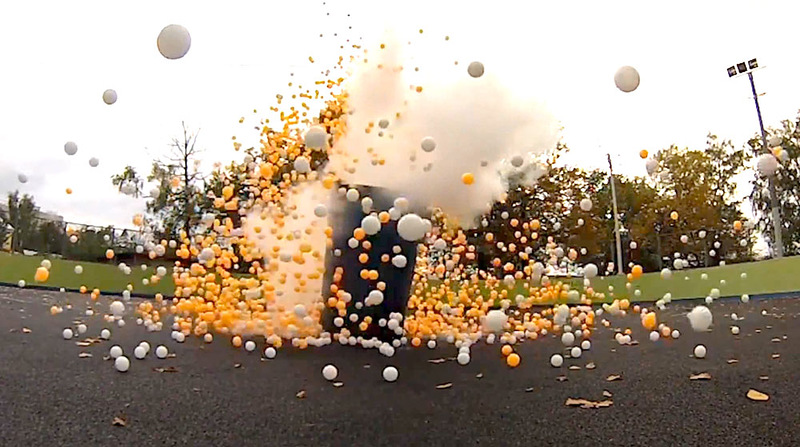
On the channel SIMPLE SCIENCE appeared the heading "Simple Scientific Experiments", which we created together with the channel Science 2.0 . Together with me, Anton Voitsekhovsky , author and presenter of the EX Experimentation program, leads the rubric.
We decided to start with liquid nitrogen, as the most interesting and at the same time spectacular component for many experiments. For the experiments, we filled the Dewar vessel with liquid nitrogen, took a few plastic bottles, a garden plastic barrel and 5000 table tennis balls. And with all this uncomplicated belongings went into the yard.
We wanted to find out
- After what time will the plastic bottle be torn if liquid nitrogen is poured into it and the lid is tightly closed?
- In which place is the bottle broken: at the neck or the very body of the bottle?
- Which bottle will break faster: filled with liquid nitrogen by half or a quarter?
- And if a bottle of liquid nitrogen to cover the barrel?
- What happens if you put a bottle with liquid nitrogen in a barrel and fill it with tennis balls?
In four hours I managed to get answers to all the questions posed. And at the same time and make a small video about it.
')
Experiment number 1: liquid nitrogen and a plastic bottle
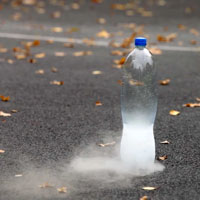
About 200 ml of liquid nitrogen was poured into a plastic bottle from under mineral water and tightly closed with a cork.
The bottle broke in about 4 minutes. Conducted 3 of the same experiment, the time ranged from 3:40 to 4:00 minutes. The errors between the experiments were obtained, probably because of the different amount of nitrogen and due to the time difference, between the pouring of nitrogen and the twisting of the lid.
Experiment number 2: two plastic bottles and different amounts of liquid nitrogen in each
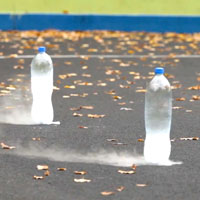
In two identical plastic bottles poured a different amount of liquid nitrogen. In the first was about half, in the second - the fifth part.
A bottle with a lot of liquid nitrogen tore apart faster, but not by much. The second one exploded in just a few seconds. Perhaps the second was hurried by the blast wave from the first bottle.
Experiment number 3: a plastic bottle with liquid nitrogen and a garden barrel on top
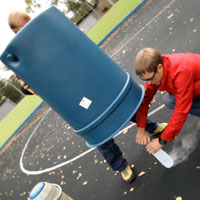
As in the first experiment, we filled the bottle with liquid nitrogen, twisted the lid and covered the top with a plastic garden barrel.
As a result of the explosion of the bottle, the barrel jumped up and took off several tens of centimeters from the ground. Given that the barrel is pretty heavy.
In the future, it will be possible to try to make a cardboard barrel in the form of a rocket, wrap it with scotch tape (as one of our viewers advised) and try to launch this construction upwards.
Experiment number 4: a plastic bottle with liquid nitrogen, a barrel and 5000 ping-pong balls
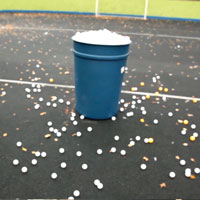
In the garden barrel put a bottle with liquid nitrogen and covered all the balls for table tennis.
Due to the fact that the bottle was in the barrel and there were balls around it, the time to burst increased more than 2 times and was about 9 minutes. The experiment was conducted 2 times in a row. In the first case, we put the bottle on the bottom of the barrel, and in the second we put it. This affected the height of the barrel jump:
- standing bottle in a barrel - 1 meter;
- a bottle lying in a barrel - 3 meters.
In one of the past posts, we showed a video with a similar experiment, which did not work. There we have a barrel torn. However, now we can say with certainty why: the barrel was made of fragile plastic. And the time before the explosion last time was much more - 15 minutes. I attribute this to the fact that the time elapsed between filling the bottle with liquid nitrogen and closing the lid was sufficient for the bottle to cool down and the nitrogen to stop boiling so much (go from liquid to gaseous).
If anyone has interesting ideas for experiments on this kind of storyline, please leave them in the comments!
Book with children's experiences
And I also want to say that our book for children with simple experiments is already nearing printing. Pre-order the book is still open.
Source: https://habr.com/ru/post/196468/
All Articles